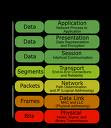A: The way in which computers are connected together with other units. The way in which cables are arranged in order to connect computers in a network
KINDS OF NETWORK TOPOLOGY

Ring topology- each node connects to exactly two other nodes, forming a circular pathway for signals. Because a ring topology provides only one pathway between any two nodes
Star topology- In its simplest form, a star network consists of one central switch, hub or computer which acts as a conduit to transmit messages. the star topology has good performance. It is scalable, Easy to set up and to expand. Any non-centralized failure will have very little effect on the network, whereas on a ring network it would all fail with one fault. Easy to detect faults It is used for centralized control
 Mesh topology- Mesh networks are self-healing: the network can still operate even when a node breaks down or a connection goes bad. As a result, a very reliable network is formed. It is only applicable for wireless networks, wired networks, and software interaction.
Mesh topology- Mesh networks are self-healing: the network can still operate even when a node breaks down or a connection goes bad. As a result, a very reliable network is formed. It is only applicable for wireless networks, wired networks, and software interaction.
 Tree topology- consists of star-configured nodes connected to switches or concentrators, each connected to a linear bus backbone.
Tree topology- consists of star-configured nodes connected to switches or concentrators, each connected to a linear bus backbone.
 Bus Topology - uses a multi-drop transmission medium, all node on the network share a common bus and thus share communication. This allows only one device to transmit at a time. A distributed access protocol determines which station is to transmit. Data frames contain source and destination addresses, where each station monitors the bus and copies frames addressed to itself.
Bus Topology - uses a multi-drop transmission medium, all node on the network share a common bus and thus share communication. This allows only one device to transmit at a time. A distributed access protocol determines which station is to transmit. Data frames contain source and destination addresses, where each station monitors the bus and copies frames addressed to itself.
7 LAYERS of OSI
 A. Physical Layer - describes the physical properties of the various communications media, as well as the electrical properties and interpretation of the exchanged signals. Ex: this layer defines the size of Ethernet coaxial cable, the type of BNC connector used, and the termination method.
A. Physical Layer - describes the physical properties of the various communications media, as well as the electrical properties and interpretation of the exchanged signals. Ex: this layer defines the size of Ethernet coaxial cable, the type of BNC connector used, and the termination method.
B. Data Link Layer - describes the logical organization of data bits transmitted on a particular medium. Ex: this layer defines the framing, addressing and check summing of Ethernet packets.
C. Network Layer - describes how a series of exchanges over various data links can deliver data between any two nodes in a network. Ex: this layer defines the addressing and routing structure of the Internet.
D. Transport Layer - describes the quality and nature of the data delivery. Ex: this layer defines if and how retransmissions will be used to ensure data delivery.
E. Session Layer - describes the organization of data sequences larger than the packets handled by lower layers. Ex: this layer describes how request and reply packets are paired in a remote procedure call.
F. Presentation Layer - describes the syntax of data being transferred. Ex: this layer describes how floating point numbers can be exchanged between hosts with different math formats.
G. Application Layer - describes how real work actually gets done. Ex: this layer would implement file system operations.











No comments:
Post a Comment